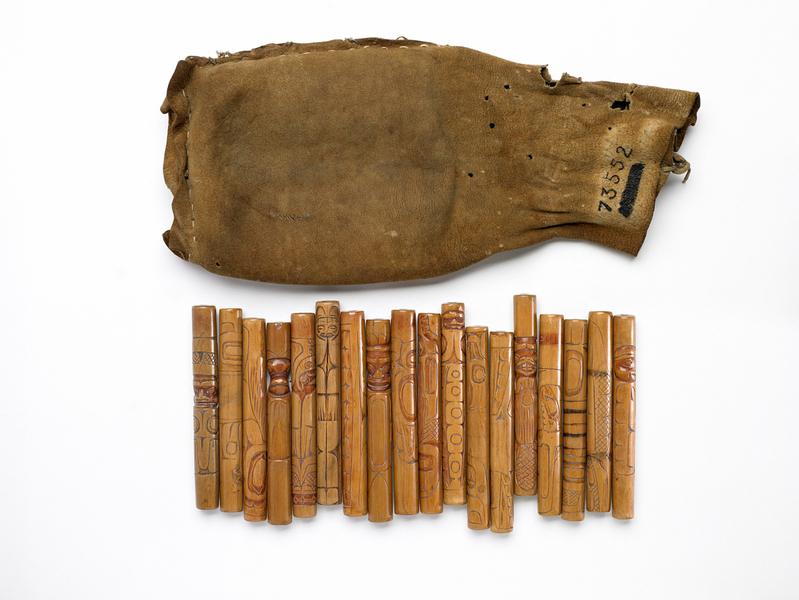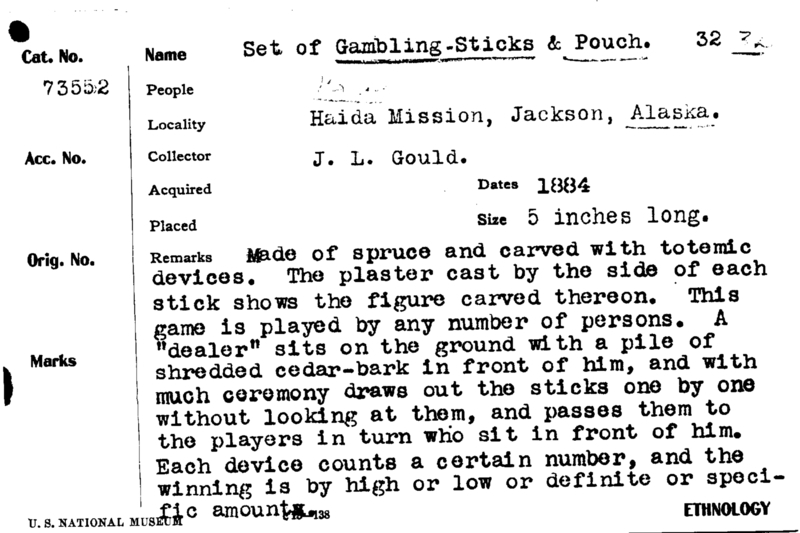Set Of Gambling-Sticks & Pouch Item Number: E73552-0 from the National Museum of Natural History



Notes
From card: "Made of spruce and carved with totemic devices. The plaster cast by the side of each stick shows the figure carved thereon. [Plaster casts are # E73552-1].This game is played by any number of persons. A 'dealer' sits on the ground with a pile of shredded cedar-bark in front of him, and with much ceremony draws out the sticks one by one without looking at them, and passes them to the players in turn who sit in front of him. Each device counts a certain number, and the winning is by high or low or definite or specific amount"8 of the gambling sticks are illus. Pl. V, after p. 260, in the B.A.E. 24th Annual Report - Stewart Culin, "Games of the North American Indians" - (under incorrect catalogue # of 73522). The game is also described/discussed on pp. 260-263 of that publication and identified as stick game.This object is on loan to the Anchorage Museum at Rasmuson Center, from 2010 through 2027. E073552-0 whole set on loan. 18 gambling sticks and bag on display and 14 gambling sticks for storage in exhibition's Community Consultation Room. E073552-1 (cast) is not on loan.Source of the information below: Smithsonian Arctic Studies Center Alaska Native Collections: Sharing Knowledge website, by Aron Crowell, entry on this artifact http://alaska.si.edu/record.asp?id=607 , retrieved 8-12-2011: Gambling sticks Stick gambling, often for very high stakes, was a fast-paced contest between two men or as many as a dozen players on each side. Each man owned several sets of thirty to seventy polished sticks and switched them during play to better his luck. Most pieces had carved or painted designs, but several called jil (bait) were plain. The rules varied, but in basic play the dealer shuffled two or three handfuls of the sticks, including one jil, beneath a mound of shredded bark; his opponent then guessed which pile held the bait.Illus. Fig. 9.6, right, p. 151 in Yanicki, Gabriel & Ives, John. "Mobility, Exchange, and the Fluency of Games: Promontory in a Broader Sociodemographic Setting. " In Prehistoric games of North American Indians: Subarctic to Mesoamerica, ed. Barbara Voorhies. University of Utah Press, 2017, 139 - 162.
Item History
- Made in Howkan, Long Island, Alaska, USA
- Collected in Howkan, Long Island, Alaska, USA
- Received from Rev. J L. Gould during 1884
What
- Name
- Set Of Gambling-Sticks & Pouch
- Identification Number
- E73552-0
- Type of Item
- gambling set
Who
- Culture
- Haida ?
- Received from
- Rev. J L. Gould
Where
- Holding Institution
- National Museum of Natural History
- Made in
- Howkan, Long Island, Alaska, USA
- Collected in
- Howkan, Long Island, Alaska, USA
When
- Acquisition Date
- during 1884
Other
- Accession Number
- 014917